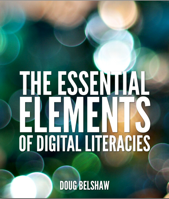
Thus, different disciplines may place a greater or lesser emphasis on certain elements (a useful analogy might be the baking of a cake by different people with the same ingredients but used in different amounts). When we analysed and coded discipline specific definitions of DL and attributes from the Faculty Learning Communities, for example, there was a greater emphasis on the Civic element in Humanities and Social Sciences, while the School of Management had a higher percentage of the Creative element compared to other faculties.
While all graduate students will be expected to have core skills, attributes and identities, discipline-specific literacies will build upon these core elements. They provide a foundation on which more subject/discipline-specific and contextual literacies can flourish.
What might these elements look like from the point of view of students looking to recognise and develop their digital literacies? The following is adapted from Belshaw 2011:
CULTURAL
Developing my cultural component of digital literacy means that I am able to move easily between different digital environments and use learning technologies in a variety of different contexts. For example I know how to distinguish between using Facebook for my personal and social connections, and using it for my academic course. I am also aware of the norms, values and codes that are specific to my subject and how these might impact on my use of learning technologies.
COGNITIVE
I need to master the ‘how-to’s of specific tools and technologies that are important for my development as a graduate, including those which are subject-specific as well as more general tools that will make me a more digitally literate person. I will develop my cognitive element by engaging with a wide range of operating systems, platforms, devices and software and looking for devlopmental and training opportunities that expose me to these tools.
CONSTRUCTIVE
To develop the Constructive element I need to understand and demonstrate how to take existing resources and content and re-use/remix it to create something new that benefits my learning. I also need to show awareness of the different ways I can license resources so that others can benefit from the content that I create.
COMMUNICATIVE
I need to understand the importance of networks and communication and the important role they play in developing my digital literacy. This includes understanding the many different ways I can communicate with different devices, including mobile and other digital devices. I also need to develop an understanding of the particular norms, values, protocols and ethics that are appropriate to social networking and other web 2.0 technologies.
CONFIDENT
To be a confident user of digital technologies I need to understand and capitalise upon the differences between the analogue and digital worlds. I need to assess and review my own competence with digital technologies, manage my own digital personal learning environment, and develop a community of practice to help me progress my skills and attributes.
CREATIVE
To develop my Creative element I will use digital technologies to create new things which have value to myself and others. I need to be prepared to take risks and to value randomness and discovery when engaging with digital technologies. I will develop an understanding of the processes, procedures and systems that lie behind digital technologies rather than the specific elements of software/hardware involved.
CRITICAL
I need to be a critical user of digital technologies by becoming aware of the power structures and assumptions behind different digital tools and practices. For example I need to think about my audience and how they might interpret my digital texts in different ways. I also need to develop an understanding of online security, identity and data management in my own literacy practices.
CIVIC
I need to make use of digital technologies in order to prepare myself to participate as fully as possible in society. I will develop an awareness of how my digital environment can help me self-organise and foster links with local, national and global organisations. I will look for opportunities for public engagement, global citizenship and the enhancement of democracy through my use of digital technologies.
Reference:
Doug Belshaw (2011) The Essential Elements of Digital Literacies. Available from http://dougbelshaw.com/ebooks/digilit/ under a CC BY license.

